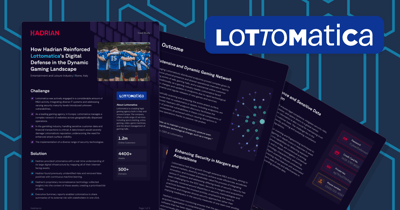Security Solutions | 4 mins
Red team cybersecurity: Everything you need to know

Just as there are many different cybersecurity threats today, there are also a number of different approaches to combat against them. One is red teaming which aims to use the tactics employed by cyber attackers against them. By understanding how they work, it is more likely that organizations will be able to stop them.
What is red teaming?
Red teaming is used by security personnel as an attack tactic that tests how an organization would respond to a genuine cyberattack. The red team is the name given to the group ‘pretending’ to carry out the attack and the red team assessment may be carried out by a third-party ethical hacking team or in-house security personnel.
How does red teaming work?
Red teaming is simply a form of penetration testing - but with very different methods from those traditionally employed. For instance, red team objectives are target-driven. The red team is given an objective, such as gaining access to a database of sensitive information, and can exploit any weaknesses they find in order to achieve this aim.
Often an organization's security personnel are not informed of a red team attack in advance, simulating the most authentic conditions of a genuine cyberattack. In addition, this allows both parties to learn from one another: the red team can uncover new weaknesses and cybersecurity personnel can develop new defense techniques.
Because cyberattacks can adopt many methods, a red team attack usually employs a variety of different approaches. However, in general terms, most red team activities begin by examining threat intelligence insights to understand how real-world cyber attackers operate. At this point, the red team will look to emulate attack methods that have been observed in the wild or follow guidance from the company itself after it has assessed its own weaknesses.
The pros and cons of red teaming
The benefits of red teaming are numerous. Firstly, it provides an objective assessment of an organization's cyber defenses that wouldn’t be possible with traditional penetration testing. Due to the adversarial nature of red teaming, weaknesses that previously remained undiscovered are rooted out. Any route that allows the red team’s objective to be achieved is permitted.
The main benefit of red teaming, however, is the clarity it gives organizations over any vulnerabilities that may exist - and how they should react in the event of a genuine cyber attack that targets them. Often red team collects all the results of its tests together and provides a clear summary of its findings. From this information, organizations can patch weaknesses, shift security policies, or change parts of their IT stack entirely. The red team highlights where the vulnerabilities are - organizations then decide what to do about them.
However, red teaming does come with its challenges. Red teaming can be time and resource intensive and so, as a result, is often only done annually and by an external team. For instance, research indicates that 39% of companies perform red team tests once every seven to 11 months and 27% just once a year.
For red teaming to be conducted, information needs to be gathered, attacks need to be planned, and then a report has to be made following the attack. While red teaming can be an effective method of identifying weaknesses, it may not be quick enough to prevent a cyberattack - particularly if it is infrequently employed.
In 2022, 41 in-the-wild zero-day exploits were detected and disclosed. When organizations also consider the existing vulnerabilities that may lie hidden within their IT stack, this adds up to a huge number of potential vulnerabilities that cyberattackers could exploit. The pace of digital transformation at many companies complicates things further.
Cited as a priority by 87% of senior business leaders, digital transformation is likely to lead to the introduction of new software and hardware at many companies. But it may also lead to the introduction of new vulnerabilities too. Red teaming could discover these but if it is only carried out once a year, it may be too late by then.
Make your security dynamic
Given that the tech environments for many companies are dynamic, changing on a weekly or even daily basis, a continuous approach to red teaming is necessary. Fortunately, this is possible if businesses select the right cybersecurity platform.
Continuous Autonomous Red Teaming (CART) adds automation to traditional methods of red teaming so ongoing checks to an organization’s security protocols are carried out regularly. Using a combination of threat intelligence, automated tools, and human experts, CART simulates cyberattacks, using automation to test continuously. This means that red teams aren’t on standby until an arbitrary point, say, six months or a year later before they are utilized.
The benefits of automated red teaming include that it is consistent and continuous. Vulnerabilities, misconfigurations and exposed sensitive files are tested for regularly using advanced threat simulations and real-world scenarios, so organizations gain comprehensive visibility into the risks they face.
By adopting CART, organizations take away the burden of conducting manual processes from their security teams. Instead of focusing on testing, teams can work on resolving issues and implementing fixes that keep networks secure. This provides a financial benefit too. Security budgets can be optimized because CART takes on much of the workload.
From reactive to proactive
Red teaming has gained a strong reputation as an effective way of safeguarding against cyber threats. However, since red teaming emerged as a security method, cyber attackers have become increasingly advanced and adept at launching new exploits. The old approach of running a red team test once a year is no longer fit for purpose.
CART takes the benefits of red teaming - its objectivity, its adversarial nature, and its hacker mindset - and modernizes it to suit an age where the threat landscape shifts more rapidly than ever. Organizations need to move away from annual testing, which will always be reactive, to a proactive continuous process enabled by CART. By triggering new red team tests automatically, organizations can focus on introducing new technologies that take their business to the next level without worrying if they are introducing new vulnerabilities at the same time. CART makes red teaming fit for the modern threat landscape.





